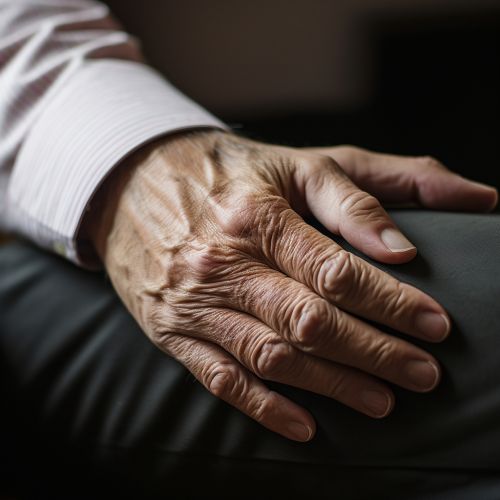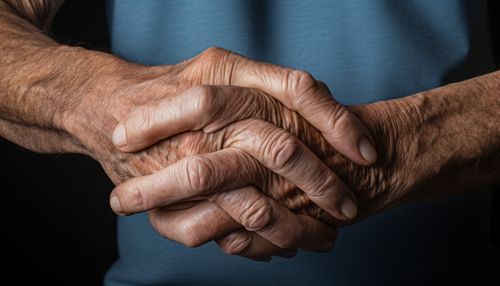Arthritis
Overview
Arthritis is a term that refers to a group of diseases causing pain and inflammation in the joints. It is a common condition that affects people of all ages, including children. The most common types of arthritis are osteoarthritis and rheumatoid arthritis, but there are many other forms, including gout, lupus, and fibromyalgia. Arthritis can cause a variety of symptoms, including pain, swelling, stiffness, and reduced range of motion. Severe arthritis can result in chronic pain, inability to perform daily activities and make it difficult to walk or climb stairs. Arthritis can cause permanent joint changes, and these changes may be visible, such as knobby finger joints, but often the damage can only be seen on X-ray.


Types of Arthritis
There are more than 100 different types of arthritis, each with its own set of symptoms and treatment options. The most common types include:
Osteoarthritis
Osteoarthritis is the most common form of arthritis. It occurs when the protective cartilage that cushions the ends of your bones wears down over time. It can affect any joint in your body, but it most commonly affects the joints in your hands, knees, hips and spine.
Rheumatoid Arthritis
Rheumatoid arthritis is an autoimmune disorder that primarily affects the joints. In an autoimmune disorder, the body's immune system mistakenly attacks its own tissues. In rheumatoid arthritis, the body's immune system targets the lining of the joint capsule, a tough membrane that encloses all the joint parts, causing inflammation that can eventually result in joint deformity and bone erosion.
Psoriatic Arthritis
Psoriatic arthritis affects some people who have psoriasis, a condition that features red patches of skin topped with silvery scales. Most people develop psoriasis first and are later diagnosed with psoriatic arthritis, but the joint problems can sometimes begin before skin patches appear.
Gout
Gout is a type of arthritis that occurs when urate crystals accumulate in your joint, causing the inflammation and intense pain of a gout attack. Gout can come and go in episodes or, if urate crystals are not managed, it can become chronic, causing ongoing pain and disability.
Causes and Risk Factors
The causes of arthritis depend on the form of arthritis. Causes include injury (leading to osteoarthritis), abnormal metabolism (such as gout and pseudogout), inheritance (such as in osteoarthritis), infections (such as in the arthritis of Lyme disease), and an overactive immune system (such as rheumatoid arthritis and systemic lupus erythematosus).
Risk factors for arthritis include:
- Family history: Some types of arthritis run in families, so you may be more likely to develop arthritis if your parents or siblings have the disorder. Your genes can make you more susceptible to environmental factors that may trigger arthritis.
- Age: The risk of many types of arthritis, including osteoarthritis, rheumatoid arthritis and gout, increases with age.
- Sex: Women are more likely than men to develop rheumatoid arthritis, while most of the people who have gout, another type of arthritis, are men.
- Previous joint injury: People who have injured a joint, perhaps while playing a sport, are more likely to eventually develop arthritis in that joint.
- Obesity: Carrying excess pounds puts stress on joints, particularly your knees, hips and spine. People with obesity have a higher risk of developing arthritis.
Diagnosis
Diagnosing arthritis often involves a thorough physical examination and diagnostic tests. A doctor will check the patient's joints for swelling, redness, and warmth. They may also want to see how well the patient can move their joints. Depending on the type of arthritis suspected, the doctor may suggest some of the following tests:
- Blood tests: These can help determine the type of arthritis a patient may have. For example, people with rheumatoid arthritis often have an antibody called rheumatoid factor (RF) in their blood.
- Imaging tests: These might include X-rays, which can reveal bone damage and cartilage loss. A doctor may also request an MRI or ultrasound to get a better look at the joints and surrounding tissues.
- Joint fluid analysis: This involves drawing fluid from the affected joint and examining it under a microscope. It can help rule out other conditions and identify the type of arthritis.
Treatment
There is no cure for arthritis, but there are many treatments that can help slow down the condition and provide some relief. Depending on the type of arthritis, treatment may include:
- Medications: These can help manage symptoms of arthritis, including pain and inflammation. Some drugs used to treat arthritis include nonsteroidal anti-inflammatory drugs (NSAIDs), corticosteroids, and disease-modifying antirheumatic drugs (DMARDs).
- Physical therapy: This can help improve flexibility and strength, and it can also help manage pain.
- Surgery: In some cases, surgery may be necessary. This could involve joint replacement or joint fusion.
Living with Arthritis
Living with arthritis can be challenging, but there are many strategies and resources that can help. Regular exercise, a healthy diet, and maintaining a healthy weight can all help manage symptoms and improve quality of life. It's also important to get plenty of sleep, as fatigue can make symptoms worse.
Support from friends, family, and healthcare professionals can also make a big difference. There are also many support groups and organizations that can provide information and resources.
